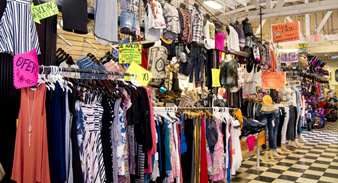Because 1979, El Faro Plaza has become Los Angeles's best indoor market, featuring over 250 vendors, crafters, artists from all over the world, a real mix of Angelenos. This indoor swap meet, located in Los Angeles, is a one-stop shopping mall providing a wide variety of shops, food vendors, and home entertainment for the entire family. And all at an excellent cost! From foot massages to car window tinting, from underwear to quinceanera dresses, from unique birds to televisions, we have it all under one giant roof.An indoor swap meet in the United States, specifically Southern California and Nevada, is a type of bazaar, an irreversible, indoor shopping center open throughout typical retail hours, with fixed cubicles or storefronts for the vendors.Indoor swap meets home vendors that offer a wide array of products and services, especially clothes and electronics. For instance, suppliers in the Fantastic Indoor Swap Meet in Las Vegas offer
clothing, furnishings, handbags and toys, ... however there's a load more: flowers and plants, family pet materials, leather goods, sporting devices, perfume and cosmetics, baggage and electronics, to call just a couple of. There also are cubicles for services, including window tinting, palm reading, changes, engraving and estate preparation. The majority of products sold here are brand-new, although antique alley does include some vintage and second-hand items. It is different in format to an outside swap meet, the equivalent of a flea market, typically open on a limited variety of days and often without repaired locations for its vendors.

Indoor swap meets exist in numerous working-class neighborhoods across Southern California, with a concentration in Central Los Angeles. Indoor swap meets consist of the Anaheim Marketplace, Fantastic Indoor Flea Market in Las Vegas, and the High Desert Indoor Swap Meet in Victorville. [5] Longstanding indoor swap meets that are now defunct consist of the Pico Rivera Indoor Swap Meet [6] and San Ysidro Indoor Swap Meet.Swap fulfills in the U.S. long consisted of U.S.-born suppliers who sold primarily secondhand items in outdoor areas. In the 1970s, Latino immigrants started offering cultural items and budget-friendly services at swap meets in Southern California and some swap meets started looking like the tianguis, open-air markets, of Mexico. At the same time, drive-in movie theaters were ending up being less popular, and their owners excitedly rented them out throughout the day to outdoor swap meets, which multiplied. Then, mostly Korean immigrants utilized their connections in the Additional hints growing import/export trade with Asia to set up their own swap meet stalls and stock them with brand-new, inexpensive items from Asia instead of secondhand items. In the 1980s and 1990s as properties South Los Angeles and parts of Central L.A. ended up being abandoned and therefore, low-cost, Korean immigrants bought them and turned them into indoor swap meets.